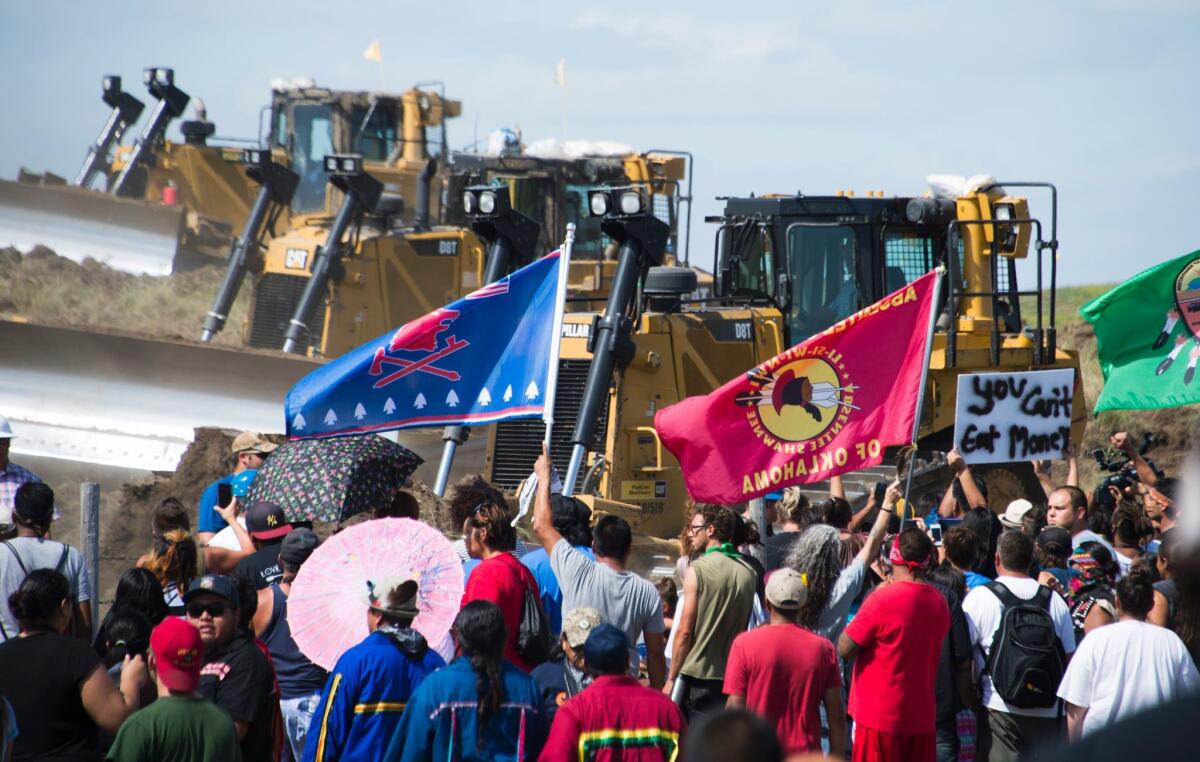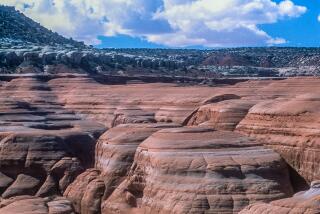Opinion: How the showdown at Standing Rock mirrors our troubled democracy

The dramatic protests against an oil pipeline in North Dakota began with the local Standing Rock Sioux tribe, which fears the project could contaminate its water supply, but has grown into something much larger, and more contentious. And that could bode either ill or well for a nation that is so disengaged with politics and its government that it elected Donald J. Trump as president.
The project itself sneaked onto the national stage in part due to the nature of regulations. Because the 1,170-mile pipeline from North Dakota to Illinois is being built primarily on private land, it did not need a start-to-finish permit from the federal government, just signoffs by the Army Corps of Engineers where the path crossed waterways — including the Missouri River, near where the showdown is taking place.
That’s despite the large capacity of the project — it will move half a million barrels of crude oil a day, the kind of undertaking one would hope would get a sharp-eyed environmental review. But as William Yardley pointed out in The Times’ news pages a couple of weeks ago, because the Dakota Access Pipeline involves primarily private land, the reviews were limited:
“Rather than broadly examining the impact a major pipeline could have across its length, looking at cumulative effects on water, air quality, land and animal species or the climate-changing emissions a pipeline might enable, the Corps typically assesses big pipelines as a series of much smaller ones, sometimes hundreds of smaller ones — breaking them up into segments to be reviewed at specific water and wetland locations.”
No wonder the environmentalists are upset.
“It’s in violation with, if not the law itself, certainly the spirit of the law,” Jim Murphy, a National Wildlife Federation lawyer, told Yardley.
But it has been Native Americans flocking to Standing Rock from around the country who have propelled what at first seemed like a small protest onto a national, and even international, stage. It is now drawing support from nonnative progressives who have similarly either gone to join the fight or are planning to (I know of a group from Detroit’s progressive community who are about to go; a family friend is leaving a just-finished political campaign to go; and the son of a friend is already there).
That is a sign of a broken democracy, and it’s been busted for a long time.
What do they hope to achieve? Well, stopping the pipeline, obviously, to both preserve the Standing Rock Reservation’s water supply and to stymie yet another effort to expand the nation’s fossil-fuel infrastructure even as the vast majority of us — except, notably, Trump — recognize that burning fossil fuels is leading to potentially catastrophic climate change.
But the protest also, in the wake of Trump’s election, is assuming a larger status as a symbol of opposition to a government, no matter who is in charge, that seems to be gamed for the benefit of special interests (in this case, the oil industry) rather than the people the government ostensibly represents.
And that’s where the violent turn of the protests becomes something of a Rorschach test. I’ve been in or near enough protests to know that no version of events is completely reliable. Protesters say they were behaving peacefully when a phalanx of militarily equipped police began firing rubber bullets, stun grenades (there were unconfirmed reports that a protester’s shattered arm may be amputated), and water cannons. The police say they were responding to rock-throwing protesters trying to dismantle a roadblock separating them from the construction site.
There’s likely truth in both accounts, but focus on the details of the skirmishes — some of it was aired live on social media — deflects from the broader issues that led to the protests in the first place: the sense that government, and the democracy, are not mediating competing political interests evenly, or fairly.
It was disaffection with politics as usual that led the left to propel Bernie Sanders’ run for the Democratic presidential nomination, and rallied the center-right and far right in enough states to give the electoral college to Trump. But remember, Trump won the nomination with less than a majority support of his own party, and received only 47% of the popular vote (behind Hillary Clinton) in the general election — and only 26% support from all eligible voters.
The turnout was within range of prior national elections, in which nearly half the country defers to a minority of eligible voters to determine the nation’s direction. There’s an argument to be made that people who don’t vote deserve the results that arise.
But when nearly half an electorate decides, for whatever reason, legitimate or not, that it’s not worth their time to vote, the democracy is weak. And when the people who vote elect someone who intends to dismantle not only the status quo, but large chunks of the government itself, then the signal, unintended or not, is that the nation is rejecting the government.
Under the Obama administration, frustrations led to people occupying Wall Street, marching the streets of Ferguson and Baltimore, or standing at remote barricades on the Great Plains facing down police water cannons, rubber bullets and pepper spray.
As Washington takes a hard-right turn under Trump (judging by his early appointments), we may be in for four long, street-filled years.
Follow my posts and re-tweets at @smartelle on Twitter
More to Read
A cure for the common opinion
Get thought-provoking perspectives with our weekly newsletter.
You may occasionally receive promotional content from the Los Angeles Times.







